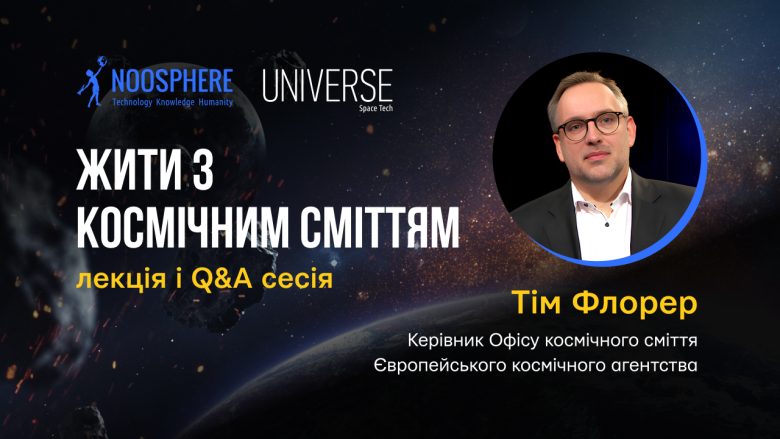As part of its event Beyond The sky: The Great Space Cleanup, Association Noosphere organized a lecture by Tim Florer, head of the European Space Agency’s Space Debris Office. He talked about the pollution of the Earth’s orbit, debris monitoring, and ways to solve the problem.
More than 300 people from all over Ukraine registered for the online lecture, and more than 700 people watched it on the social media channels of the magazine Universe Space Tech. The lecture was followed by a Q&A session with Mr. Florer, where attendees asked questions about nuclear energy in space, anti-satellite technologies, and whether space debris threatens the surface of the Moon and Mars.
Here are some of the lecture’s key points:
What is space debris?
Everything we consider space debris is related to human activity since 1957. Since then, there have been approximately 6,500 successful space launches on various types of rockets and satellite carriers. There is a variety of equipment on Earth that helps track space debris. This equipment creates catalogs with all the parameters of these objects, thereby allowing us to monitor the evolution of space.
Space debris is artificially-created objects that are no longer functional, as well as their parts and elements, that are in Earth’s orbit or returned to the atmosphere. As of today, we know of about 32,000 different objects in space, with 15,000 of this number being space debris. Almost a quarter, 7.5 thousand, are active satellites, of which 3.5 thousand belong to the Starlink constellation. There are also 2,700 inactive satellites, 2,200 rocket stages, and about 1,400 objects associated with various space missions.
There are also millions of objects smaller than a centimeter in diameter, and hundreds of millions which are at least a millimeter in size.
How has humanity polluted space?
We monitor changes to how space is being used, first and foremost statistics. Until 2015, we had a bit over a hundred new objects in low orbit every year. After 2015, this number doubled to 200 objects. Then something happened, and there was a very strong jump. Now, there are 2,500 objects launched by people into space every year.
We need to realize that the use of space is changing. If previously it was used for military and public purposes, now it is a very commercialized domain. We depend on these services, as each of us directly or indirectly uses space technology every day. This trend will continue, with whole constellations of satellites expected to be launched.
In everyday life, you find the most garbage where the largest number of people pass through. It is similar in space: the most debris is where there are large constellations of satellites. This is a problem for astronomers because these objects can get in the way of their scientific work. Therefore, it is very important to find a way to use space that does not interfere with science.
Launches are the main source of debris, but a significant part of it is wreckage which comes from explosions and collisions. Other sources include leakage of coolants or the destruction of material. All this constantly increases the amount of space debris.
Can space debris fall to Earth?
It does. While this might seem frightening, but in reality, space junk ends up burning up in the atmosphere. How long does it take?
It all depends on the size of the debris. Smaller objects fall with considerable speed, while large, massive satellites barely pass through the atmosphere, given their structure. If we take something in an 800 km orbit, which is used quite often, a satellite the size of a shoebox takes 50 years to burn up. A huge satellite needs a century. And small grains of sand need several years.
That is why there is much less debris in the 500-kilometer orbit. And this is one of the reasons why space tourism missions do not go higher: to avoid collisions.
We had an experience where our satellite being used to deliver cargo to the ISS descended into the atmosphere. There are parts that do not burn, like fuel tanks. Therefore, they can also be found on Earth. But you won’t see craters in the photo. These are not comets or asteroids that hit the earth. Space debris lands slower and more gently.
Is it possible to clean space, and how many years will it take? A lecture by Tim Florer.
